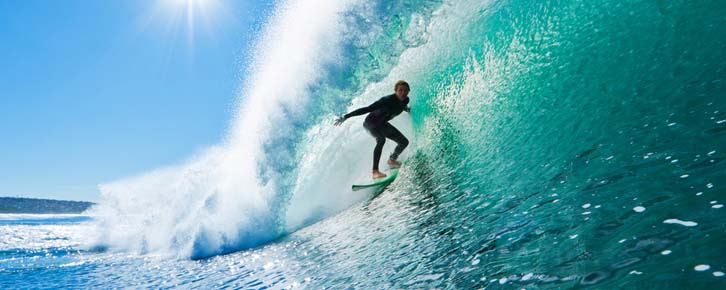Surfing is a sport that demands a lot from the athlete in every way. That’s why surfers must always be in a dynamic balance, because the board will slide on the wave, which is a mobile surface, and undergoes several modifications, thus changing the center of gravity of both the athlete and the equipment.
The type of wave, the winds, and the type of tide are variable and can directly influence the moment when these surfers are going to practice the sport.
In addition to surfing being a sport that requires great attention or conditioning when in action, surfers practically use all physical abilities such as balance, strength, endurance, flexibility, and power.
With this huge demand on the body, a lot of care is needed, especially with supporting the spine, so it is necessary that this surfer has great muscle support.
But what not everyone knows is that the Pilates Method can be a great ally to surfing, helping this surfer when acquiring balance and physical conditioning.
Why should surfers practice Pilates?
About three in ten athletes complain of back pain, with back pain being among the most common in surfers.
It is estimated that 90% of athletes will have some type of spinal problem throughout their lives, and on average the vast majority improves between four and twelve weeks, thus returning to surfing, however, the problem can become chronic if it is not Caution.
According to the evaluation of the professional team, within the Pilates Method, joint mobility work can be emphasized, in addition to muscle strength, since many surfers have local contractures that can be relieved with this emphasis.
What the Pilates Method does is to strengthen the “core”, an area of the body that will act as a very strong belt, capable of involving and supporting the entire spine. Think of it securely and mobile forwards, backward, sideways, rotating, and safely absorbing impacts.
The essential exercises are those that approach the movements used by the surfer in the water, that is, training that uses great instabilities such as: squatting on top of the ball, exercises on top of the Bosu, balance on the roller, plane, spine extensions with rotation, bridges, in addition to advanced boards, reducing support bases and on unstable bases.
Stretching, in general, helps maintain muscle balance.
It is common for surfers to suffer from back pain, knee and shoulder problems. In Pilates, you can do training to strengthen all muscle groups, especially the core, located in the trunk region as mentioned above, which helps us to maintain posture.
On the longboard, one of the favorites of practitioners of this sport, it weighs almost ten kilos, that is, muscle strengthening through Pilates is also important.
For high-performance athletes or at the competition level, correct training in sporting gestures and specific physical preparation for surfing is necessary.
Thus, the lack of physical fitness related to inactivity, training overload and complementary activities, lack of preparatory activities before surfing are some of the factors that enhance these surfers’ chances of future postural changes.
In addition, you can adapt the Pilates class for surfing to work on possible difficulties or deficiencies, such as lack of flexibility, strength, and balance, or even improve aerobic conditioning.
Benefits of Pilates for Surfers
Pilates works in several ways for surfers, with the following objectives and benefits:
- Strengthening of the muscles of the spine, shoulders, and arms, making paddling easier
- Relief of pain in the lower back, neck, and knees
- Improved balance
- Greater agility and flexibility
- Concentration
- Increased flexibility
- Correction of postural problems
- Improve motor coordination
- Waist dissociation
- axial elongation
- proprioceptive stimulation
- muscle relaxation
- Improve breathing capacity
- Increased body awareness
Pilates is an excellent tool for preparing surfers who are looking to beat big waves and have greater stability on the board and greater strength for paddling.
Exercises for surfers are aimed at improving joint stability and deep muscle strength in the feet, ankles, hips, and lower back that provide balance and improve the ability to stand on an unstable structure such as a board for longer.
Pilates helps support the spine extension and the stability of the scapulae, so important to keep the chest off the board and ensure greater efficiency of the arms in the water.
The idea is to use the Method’s equipment to work the body in a global and unique way, respecting the limits of each one.
Analyzing the practice of surfing and observing the main deficiencies during each phase of the practice is essential for setting up an adequate training system, in order to reduce the incidence of any dysfunction that is causing pain, injury, or decreased performance.
Even with an expressive number of surfers, the practice of the sport is not always linked to good physical conditioning, knowledge of sports gestures, and use of adequate equipment by surfers, resulting in the appearance of injuries and consequently bodily discomfort and possible changes postural or pathologies.
Conclusion
Developing flexibility through Pilates allows you to increase joint range of motion, reducing the risk of muscle injuries and improving performance.
In surfing, flexibility can be improved through stretching exercises within a specific Pilates workout for this group.
The strengthening of the main body muscle groups through Pilates is also important, especially those most demanded during the performance of the sport in question, it is essential to maintain good postural conditions as well as to prevent injuries resulting from surfing.
Thus, the Pilates Method is an essential and recommended technique in rehabilitation, post-rehabilitation, and also in conditioning, acting in prevention, and in the training of surfing athletes.
Discover more from Pilates All Ages
Subscribe to get the latest posts sent to your email.
